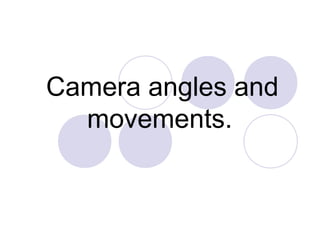
Camera angles and movements
- 1. Camera angles and movements.
- 2. All films have specially picked camera movements or angles to create the best and right mood for the audience.
- 3. Tracking shot This is where the camera is usually mounted on a cart with wheels called a dolly which allows a smooth long shot to be filmed. It can be used to show parallel action to what is in the film like a running race, the dolly will go along with the runner and will always be filming him or her. Another popular way it is used is when following someone walking and the camera is focused on their feet, this lets the audience feel they are keeping up with the pace and the action.
- 4. Tracking can also be used by someone holding the camera in hand. They can then track forward which draws the watcher in to the film and gives a suspense feel to the mood. Tracking backwards when the camera is pulling away from the action usually suggests that the film is going to cut to the next scene and draws the audience out.
- 5. Tilt shot Tilt shot is usually filmed on a tripod and the is similar to a pan shot but the camera only moves vertically not horizontally. Tilt shots are often used to show vertical significance i.e. height or power.
- 6. Arc shot This is a semi-circular movement around and object or a person. It increases the tension as the camera is always moving and your back turned on main characters or objects. There is a 180 degree rule in this shot and it is very effective when there is a discussion at a table or a fight.
- 7. Crane shot This is a shot usually taken from above the actor or object on a crane or jib like a type of birds eye view. They are commonly used to end films. There are two types of crane shots one is rise up, where the camera starts on the subject and rises away vertically from it and the other is fall down where the camera moves vertically downward.
- 8. Panning shot A panning shot is a movement from left to right and is usually a point of view shot. The camera only moves horizontally. The effect is sometimes enhanced by adding other effects like zooming in or out on the subject. This puts emphasis on the subject.